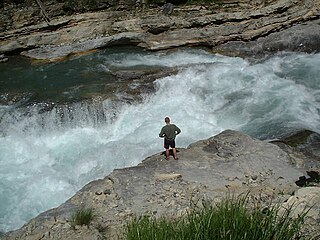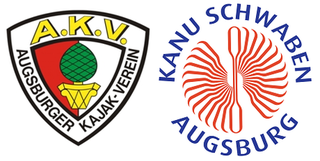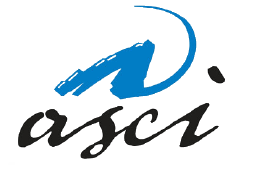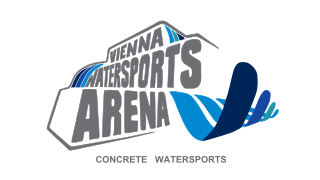
Whitewater is formed in a rapid, when a river's gradient changes enough to generate so much turbulence that air is trapped within the water. This forms an unstable current that froths, making the water appear opaque and white.

Canoe slalom is a competitive sport with the aim to navigate a decked canoe or kayak through a course of hanging downstream or upstream gates on river rapids in the fastest time possible. It is one of the two kayak and canoeing disciplines at the Summer Olympics, and is referred to by the International Olympic Committee (IOC) as Canoe/Kayak Slalom. The other Olympic canoeing discipline is canoe sprint. Wildwater canoeing is a non-Olympic paddlesport.

Canoe freestyle is a discipline of whitewater kayaking or canoeing where people perform various technical moves in one place, as opposed to downriver whitewater canoeing or kayaking where the objective is to travel the length of a section of river. Specialised canoes or kayaks (boats) known as playboats are often used, but any boat can be used for playing. The moves and tricks are often similar to those performed by snowboarders, surfers or skaters, where the athlete completes spins, flips, turns, etc. With modern playboats it is possible to get the kayak and the paddler completely airborne while performing tricks. The competitive side of playboating is known as freestyle kayaking.

The Augsburg Eiskanal is an artificial whitewater river in Augsburg, Germany, constructed as the canoe slalom venue for the 1972 Summer Olympics in nearby Munich.

An artificial whitewater course (AWWC) is a site for whitewater canoeing, whitewater kayaking, whitewater racing, whitewater rafting, playboating and slalom canoeing with artificially generated rapids.

The Savage River is a 29.5-mile-long (47.5 km) river in Garrett County, Maryland, and is the first major tributary of the North Branch Potomac River from its source. The river was named for 18th century surveyor John Savage.

Lee Valley White Water Centre is a white-water slalom centre, that was constructed to host the canoe slalom events of the London 2012 Olympic Games. On 9 December 2010, Anne, Princess Royal officially opened the venue which is owned and managed by Lee Valley Regional Park Authority. The £31 million project to construct the centre finished on schedule and was the first newly constructed Olympic venue to be completed.

The Penrith Whitewater Stadium is located near Sydney, Australia. It is an artificial whitewater sporting facility which hosted the canoe/kayak slalom events at the 2000 Summer Olympics in Sydney. The facility is part of the Penrith Lakes Scheme, which is converting open-pit sand and gravel mines into lakes for recreation. It is close to Cranebrook and is adjacent to the Sydney International Regatta Centre. These lakes are not filled via the Nepean River, but are filled via rain water and ground water. The operation of the facility aerates the water and improves water quality in the flat water rowing and canoeing course.

The U.S. National Whitewater Center (USNWC) is an outdoor recreation and athletic training facility for ice skating, whitewater rafting, kayaking, canoeing, rock climbing, mountain biking, and hiking which opened to the public on November 4, 2006. The Center is located in Charlotte, North Carolina on approximately 1,300 acres (530 ha) of land adjacent to the Catawba River, with more than 45 miles (72 km) of developed trail.

The Kananaskis River is a mountain river in western Alberta, Canada. It is a tributary of the Bow River, crossing the length of Kananaskis Country.

The Tees Barrage International White Water Course, originally the Teesside White Water Course, is an artificial whitewater course on the north bank of the River Tees, in North East England. It is part of the Tees Barrage and is located in the Stockton-on-Tees district, accessible by road only from Thornaby-on-Tees and best accessed by the A66. The course was built in 1995 at a cost of £2m. The course is now open once more under the new name TBIWWC.
Douglas Cameron Gordon, commonly known as Doug Gordon, was an American whitewater kayaker, who was a member of the U.S. Slalom Team from 1981 to 1987, and a chemist. Gordon died in Eastern Tibet when he and three other paddlers attempted the first descent of the Tsangpo River.

Parc Olímpic del Segre is a canoeing and kayaking facility in La Seu d'Urgell, Catalonia, Spain, built in 1990 for use during the 1992 Summer Olympics in Barcelona.

The Ocoee Whitewater Center, near Ducktown, Tennessee, United States, was the canoe slalom venue for the 1996 Summer Olympics in Atlanta, and is the only in-river course to be used for Olympic slalom competition. A 1,640 foot stretch of the Upper Ocoee River was narrowed by two-thirds to create the drops and eddies needed for a slalom course. Today, the course is watered only on summer weekends, 34 days a year, for use by guided rafts and private boaters. When the river has water, 24 commercial rafting companies take more than 750 raft passengers through the course each day.

The Čunovo Water Sports Centre is an artificial whitewater slalom course in Slovakia, on an island in the Danube river, 14 km southeast of Bratislava, near the village of Čunovo. It is powered by flow diversion from the Čunovo dam. Since 1997, it has hosted a full schedule of local, regional, and international competitions, including multiple World Cup races, 2 European Championships and the 2011 World Championships.

Kanupark Markkleeberg, built in 2006, is the second of two artificial whitewater canoe/kayak slalom courses in Germany, and the only one powered by pumps. The other German course is the Eiskanal in Augsburg, used in the 1972 Summer Olympic Games in Munich. Kanupark Markkleeberg is located on the southeast shore of Markkleeberger See, a lake south of Markkleeberg, a suburb on the south side of Leipzig. A former open-pit coal mine, the lake was flooded in 1999 with groundwater and developed as a water recreation area. The lake is part of the Leipziger Neuseenland, the largest landscape construction project in Europe, which is reclaiming formerly barren industrial and mining sites for recreational use.

Adventure Sports Center International is an Olympic standard white water rafting and canoe/kayak slalom center located on the mountaintop above the Wisp Ski Resort at Deep Creek Lake, McHenry, Maryland, United States. In addition to serving as a venue for slalom races and training, the center offers a range of services to the general public including guided raft trips, inflatable kayak rentals, and riverboard rentals.

The following outline is provided as an overview of canoeing and kayaking:

The Vienna Watersports Arena is an artificial whitewater venue for canoe and kayak slalom competition in Vienna, Austria, the only such facility in Austria. It also serves as a family water park, with guided raft trips and practice times for individual boaters. Located across the Danube from the city, on Danube Island, it pumps its water from the New Danube river channel. It opened in August 2013; the following June it hosted the 2014 European Canoe Slalom Championships.
































